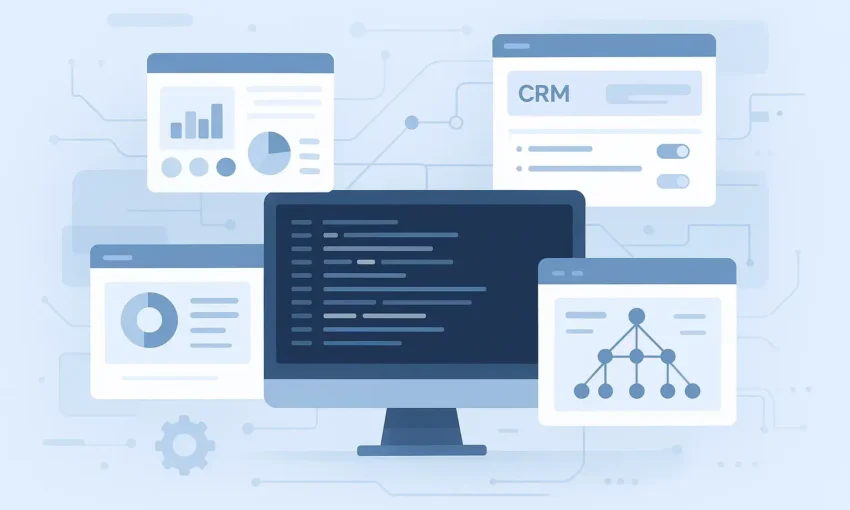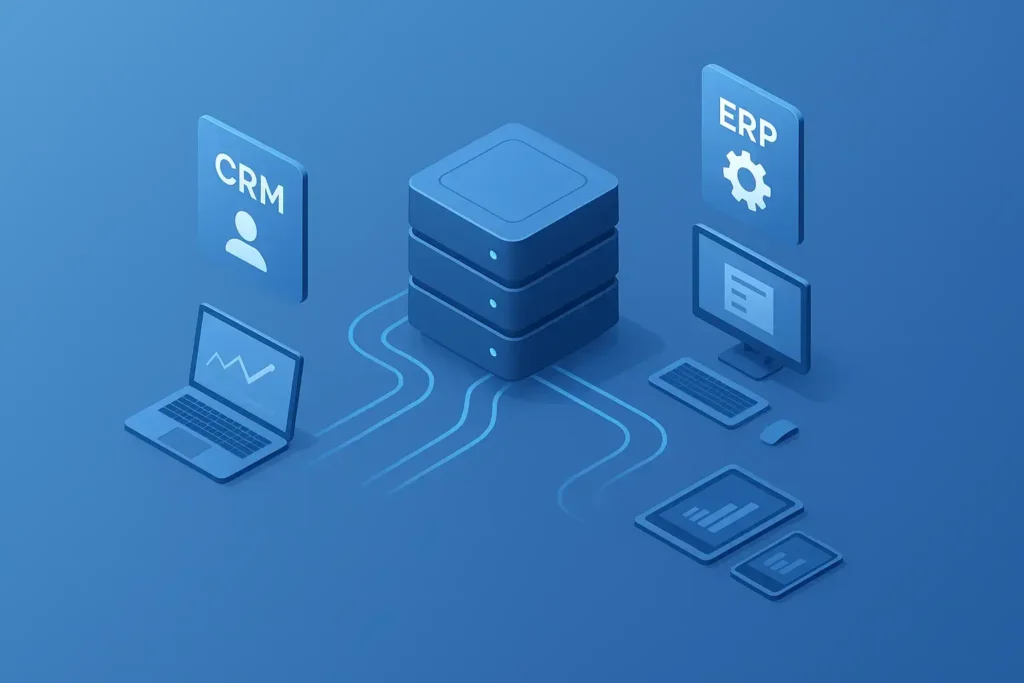B2B Custom Software Development: Your Go-To Guide

In today’s competitive business landscape, off-the-shelf solutions often fall short of meeting unique operational requirements. B2B custom software development has emerged as a strategic necessity for companies seeking to streamline processes, enhance productivity, and gain a competitive edge. This comprehensive guide explores everything you need to know about developing tailored software solutions for business-to-business applications.
What is B2B Custom Software Development?
B2B custom software development involves creating specialized applications, platforms, and systems designed specifically for business clients rather than end consumers. Unlike generic software packages, these solutions are built from the ground up to address specific business challenges, workflows, and industry requirements.
Custom B2B software encompasses various solutions, including enterprise resource planning (ERP) systems, customer relationship management (CRM) platforms, supply chain management tools, financial management systems, and specialized industry applications. These solutions integrate seamlessly with existing business infrastructure while providing scalability and flexibility that commercial software cannot match.
Key Benefits of Custom B2B Software Solutions
Enhanced Operational Efficiency
Custom software eliminates redundant processes and automates repetitive tasks, significantly improving operational efficiency. By designing workflows that align perfectly with your business processes, companies can reduce manual errors, accelerate decision-making, and optimize resource allocation.
Competitive Advantage
Tailored software solutions provide unique capabilities that competitors using standard software cannot replicate. This differentiation becomes particularly valuable in industries where operational efficiency directly impacts profitability and customer satisfaction.
Scalability and Flexibility
Custom solutions grow with your business. Unlike off-the-shelf software with fixed features and limitations, custom applications can be modified, expanded, and adapted as business requirements evolve. This scalability ensures long-term value and reduces the need for costly software migrations.
Better Integration
Custom software integrates seamlessly with existing systems, databases, and third-party applications. This integration eliminates data silos, improves information flow, and creates a unified technology ecosystem that enhances overall business performance.
Cost-Effectiveness
While initial development costs may be higher than purchasing commercial software, custom solutions often prove more cost-effective over time. They eliminate ongoing licensing fees, reduce dependency on multiple software vendors, and minimize training costs through intuitive, purpose-built interfaces.

Essential Features of B2B Custom Software
User-Centric Design
Successful B2B software prioritizes user experience through intuitive interfaces, logical workflows, and minimal learning curves. The design should accommodate different user roles, skill levels, and accessibility requirements while maintaining consistency across all modules.
Robust Security
B2B applications handle sensitive business data, making security paramount. Essential security features include multi-factor authentication, role-based access controls, data encryption, audit trails, and compliance with industry standards such as GDPR, HIPAA, or SOX.
Real-Time Analytics and Reporting
Modern B2B software must provide comprehensive analytics capabilities, including real-time dashboards, customizable reports, and predictive analytics. These features enable data-driven decision-making and help businesses identify trends, opportunities, and potential issues.
Mobile Accessibility
With remote work becoming standard, B2B software must function seamlessly across devices and platforms. Responsive design and mobile optimization ensure users can access critical business functions from anywhere, improving productivity and collaboration.
API Integration
Custom software should support robust API integrations to connect with existing tools, third-party services, and future applications. This interoperability ensures the software remains valuable as the technology landscape evolves.
The Development Process
Requirements Analysis
The development process begins with thorough requirements gathering, including stakeholder interviews, workflow analysis, and technical assessments. This phase identifies specific business needs, technical constraints, and success metrics.
Design and Architecture
Based on requirements, developers create system architecture, database design, and user interface mockups. This phase establishes the technical foundation and ensures the solution can scale and integrate effectively.
Development and Testing
Agile development methodologies ensure iterative progress with regular stakeholder feedback. Comprehensive testing, including unit testing, integration testing, and user acceptance testing, guarantees quality and reliability.
Deployment and Training
Careful deployment planning minimizes business disruption while ensuring smooth transition. User training programs help teams maximize the software’s potential and achieve desired outcomes.
Ongoing Support and Maintenance
Custom software requires ongoing support, including bug fixes, security updates, performance optimization, and feature enhancements. A reliable support structure ensures long-term success and return on investment.
Choosing the Right Development Partner
Selecting the appropriate development partner significantly impacts project success. Look for companies with proven B2B software experience, strong technical expertise, and a collaborative approach to project management. The ideal partner should understand your industry, demonstrate clear communication skills, and provide transparent project timelines and costs.
Consider factors such as the development team’s size and capabilities, their quality assurance processes, post-launch support offerings, and client references. A good development partner becomes a long-term technology advisor, not just a vendor.
Future Trends in B2B Software Development
Emerging technologies are reshaping B2B software development. Artificial intelligence and machine learning are enabling predictive analytics, automated workflows, and intelligent decision support systems. Cloud-native architectures provide improved scalability, reliability, and cost-effectiveness.
Low-code and no-code platforms are democratizing software development, allowing businesses to create and modify applications more quickly. However, complex B2B solutions still require professional development expertise to ensure security, performance, and integration capabilities.
Conclusion
B2B custom software development represents a strategic investment in your company’s future. By creating solutions tailored to specific business needs, organizations can improve efficiency, reduce costs, and gain competitive advantages that drive long-term success. The key lies in careful planning, choosing the right development partner, and maintaining a focus on user needs and business objectives throughout the development process.
Frequently Asked Questions (FAQs)
1. How long does B2B custom software development typically take?
Development timelines vary significantly based on complexity, features, and integration requirements. Simple applications may take 3-6 months, while complex enterprise systems can require 12-18 months or more. Agile development approaches allow for iterative delivery, providing value throughout the development process.
2. What is the cost difference between custom software and off-the-shelf solutions?
Custom software typically requires higher upfront investment but often proves more cost-effective long-term. While off-the-shelf solutions have lower initial costs, ongoing licensing fees, customization costs, and limited functionality can make them more expensive over time. Custom solutions eliminate recurring license fees and provide unlimited user access.
3. How do you ensure custom software integrates with existing business systems?
Integration planning begins during the requirements phase through comprehensive system analysis and API documentation review. Developers create integration layers, middleware, and data mapping strategies to ensure seamless connectivity. Thorough testing validates integration functionality before deployment.
4. What ongoing support is required after custom software deployment?
Post-deployment support includes bug fixes, security updates, performance monitoring, user training, and feature enhancements. Most development partners offer maintenance contracts covering these services. Regular updates ensure the software remains secure, efficient, and aligned with evolving business needs.
5. How can businesses measure the ROI of custom software development?
ROI measurement should include quantifiable metrics such as time savings, cost reductions, productivity improvements, and revenue increases. Track metrics like processing time reduction, error rate decreases, user productivity gains, and operational cost savings. Many businesses see positive ROI within 12-24 months of deployment.





